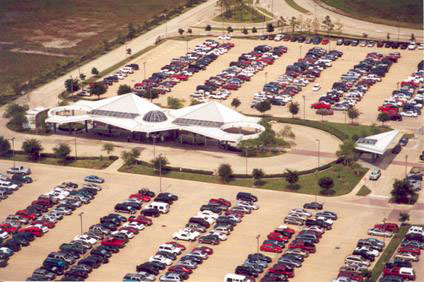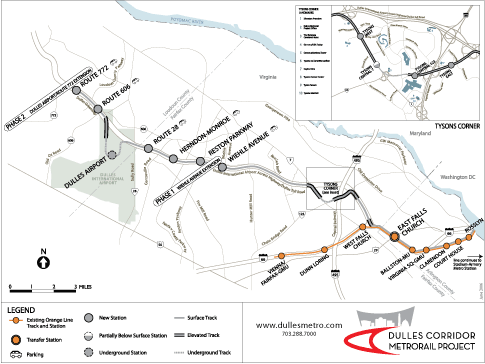Here in the Washington, D.C. area, our Metro system is expanding. A new Silver Line will go all the way to Dulles airport and beyond, into exurban Loudon County. The projected station stops are named for highways, not neighborhoods or landmarks: Reston Parkway, Route 28, Route 606, Route 772. Ten of the 11 new stations will be outside the Capital Beltway, almost doubling the number of metro stations outside the unofficial boundary of D.C.’s urban territory.
I’m always happy to see transit flourishing, and it will be nice to be able to take the metro all the way to Dulles without switching to the bus. But does transit expansion give the official thumbs-up to people moving farther and farther outside the urban core? This Silver Line isn’t being built to get me from the inner city to our ridiculously far-flung airport. It’s to provide all the benefits of transit – a reliable, congestion-free ride to work while you read the paper or doze off to your iTunes – to people who have chosen to live several counties away from their work.
Land use expert Reid Ewing, a professor of urban planning at the University of Utah and associate editor of the Journal of the American Planning Association, said transit leads to development – both sprawling and compact – because it improves accessibility. And increased accessibility to jobs in a shorter amount of time is an engine for development.
“It’s the fact that you can reach lots of trip attractions within short period of time on transit that causes development around the station,” Ewing said. “It doesn’t happen inherently. And accessibility, likewise, is a driving force in highway oriented sprawl.”
Different modes create development in different ways. Even different rail modes, Ewing said, have different potential to induce development. Light rail tends to go slower than heavy rail, and so light rail connectivity far out in the suburbs won’t be as much of a boon to a community as a faster line. So it won’t attract as many new residents to the area, whether people living in a tight circle around the station and walking to transit, or people living more spread out and driving there.
“With highway expansion you really don’t get much concentration of activity because the automobile is so flexible – it can go anywhere and it moves at fairly high speeds,” Ewing said. “The catchment area for a high performance highway is many miles. And that catchment area is likely to be developed in a sprawling pattern, because it’s auto-oriented. In the case of rail expansion, there’s at least potential to have concentrated transit oriented development around the station, then potentially sprawl feeding the station through park-and-ride.”

That’s why well-planned station area development so key. It doesn’t just make for nice, semi-urban enclaves – it channels outward development along compact corridors, says APTA President Bill Millar.
“We have a long, long history in the country of building compact towns around railroad stations,” Millar said. “We know that the value of land goes up around stations and intensity of development goes up around stations and that’s anti-sprawl.”
Besides, transit lines typically have to go through a cost-benefit analysis to acquire federal and state funding, and they need to demonstrate a certain level of projected ridership. “That is one reason why you don’t have trains to nowhere the way sometimes you have other things to nowhere,” said Sarah Kline of Reconnecting America.
Transit is generally built in response to outward development, in other words – it doesn’t cause it.
“It’s not like roads or highways that were built before these places really grew up,” Kline said. “The road gets built and then the suburb grows up and then all of a sudden no one can get into downtown anymore because it’s so congested, so they build transit. And yes, transit allows people to still live there. But what would happen if there weren’t transit? People wouldn’t all be moving in closer because there’s not enough affordable housing closer in.”
Chris Leinberger of Brookings and the University of Michigan writes extensively on the increasing demand for compact urban development. He says the lack of affordable inner-city housing Kline refers to is the product of the failure of real estate developers to adequately fill the enormous demand for compact, walkable neighborhoods. The high prices in the urban core signal the high demand in densely developed areas, according to Leinberger.
Does that mean even transit-oriented development on the fringe can be to the detriment of the city itself? The surging desire for walkability can be sated by little suburban downtowns dotted around the periphery instead of by the urban core, building up the suburbs at the expense of downtown. Here in D.C. for example: a person craving urbanism could go to Tysons or Reston or Rockville and contribute to the starvation of Washington, D.C. itself. The city’s census numbers showed a rise in population this year for the first time since 1950, but we still only have 75 percent of the population we had then. On the other hand, by relieving some of the pressure for compact neighborhoods, densely-built communities outside the city can have the effect of making housing more affordable inside the city.
Bill Millar says yes, transit lines stretch farther and farther out into the countryside, but it at least concentrates the development that’s occurring there anyway, and makes it more efficient. “Transit makes development more dense, more environmentally friendly, and increases the probability people will use car less,” he said.
But it can still be done wrong. Portland-area Congressman Earl Blumenauer said transit-oriented development can create walkable, livable communities, but “building nothing but a park-n-ride outside the station will create sprawl.”
Every transit line has some stations that fail this test – stations that are anchored in an ocean of parking, with no other services nearby. If there are no residential or commercial opportunities within walking distance of the station, no one will ever walk there. In these cases, transit is an engine for auto-oriented sprawl.
Back to the Silver Line: Four of those 11 new stations will be in and around Tysons Corner, which has embarked on a land use plan to redevelop the sprawling, auto-oriented shopping destination suburb into a walkable urban center. The placement of transit stations there fits well with their plan to increase density and pedestrian-friendliness, and even without that plan, Tysons’ population justifies a transit line.






